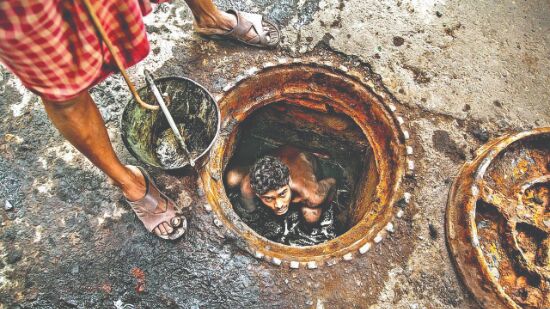At what cost?
Continued deaths of manual scavengers raise pressing questions around the liability and accountability of employers and the government

Four sanitation workers asphyxiated to death while working to improve sewerage operations at Kudghat, Kolkata on February 25, 2021. The operations were carried out by the Kolkata Environmental Improvement Investment Program (KEIIP) which aims to create a better sewerage operation and water supply in the city.
The Kolkata Municipal Corporation (KMC), through which the sewer-desilting operations were commissioned, did not have any monitoring authority. This violates the Prohibition of Employment as Manual Scavengers and their Rehabilitation Act, 2013.
Jehangir, Alamgir, Sabir and Liyakat were forced to enter the manhole on instructions of KEIIP for completing the connection of the sewer network and drainage plumbing station.
Since the KEIIP was working under the KMC, the lack of monitoring of the entire operation, because it was in its last stage, is not a proper excuse. The Prohibition of Employment as Manual Scavengers and their Rehabilitation (PEMSR) Act, 2013 prohibits both the employment and manual cleaning of sewers and septic tanks without any safety gear.
The sanitation workers in the present case drowned as they were trapped in the manhole to construct the sewer line. In this continuation, they asphyxiated to death since they did not have a safety belt attached to them.
Along with the lack of safety equipment, the absence of checking of the oxygen level became the reason for their death. The negligence to even check the water supply makes both KEIIP and the officials of KMC liable for the deaths of these four sanitation workers.
The common loophole of the PEMSR Act, 2013 of merely emphasising the safety gear as a part of manual cleaning, often makes the officials of civic bodies lie that the death was a result of 'voluntary entry' into manhole by the sanitation workers.
This is followed by a series of negotiations with the family of the deceased and the harassment of the other sanitation workers to convince them to accept 'voluntary entry.' The non-provision of safety equipment also becomes a 'voluntary refusal to wear safety gears.'
The state government also needs to answer regarding its action plan for the sanitation workers and eradication of manual scavenging. The Emergency Response Sanitation Units (ERSUs) were to be constituted to certify workers before any kind of involvement in sewer work. The question is whether these sanitation workers were certified for this scale of sewerage operation.
The second question is whether the state government was aware that KEIIP was employing sanitation workers to do this work. Since the deaths happened in the last part of KEIIP's sewerage operations, it can also be possible that sanitation workers would have entered before also to complete this part of the operation. This also makes employers a repeated offender.
Another aspect is that the promise of immediate disbursement of compensation amount cannot compensate for holding the employer liable in the case of sewer death. First, the provision of compensation of Rs 10 lakh is meagre for tackling the gravity of the problem of sewer deaths. It is certainly not enough. Second, the reality on the ground is that families of the deceased sanitation workers are harassed by officials as they have to keep appealing round after round. This makes the entire process cumbersome.
Many families keep questioning why they do not receive full compensation. The families, in this case, need to be assured that they receive the full amount.
The surviving sanitation workers, Soleman and Sariful also need to be given free healthcare facilities for their injuries.
West Bengal government also needs to participate in surveys that are conducted by researchers and non-government organizations. The state has had a history of not participating in surveys to find manual scavengers while there is prevalence of many dry latrines in its semi-urban and rural areas — 80 per cent of India's dry latrines were found in Jammu and Kashmir, Uttar Pradesh and West Bengal.
The action response to mechanisation is also not clear yet. There has been a lack of mobilisation to liberate the manual scavengers in the state from menial works. This is the reason why deaths go unnoticed.
Until the state government takes necessary steps, the machine-hole dream is far away since the sanitation workers are completely left unprotected without any safeguards. The state government also needs to answer questions related to budgetary allocation and actual expenditure for the rehabilitation of the manual scavengers.
It is noteworthy that the ironic part of the entire situation is that initiatives like KEIIP aim to provide a better quality to the citizens in terms of water and sanitation facilities but this is held on the shoulders of sanitation workers who are exploited to make the sanitation better at the cost of their own lives.
Is it right to improve a city's sanitation when the ones providing it are dying because of serious human rights violations?
The caste factor becomes prominent as inequality can be seen in the call for a better sanitation practice of the socio-economically affluent castes that are seen to be ignoring deaths after deaths of the most vulnerable. Therefore it should be noted that the right to sanitation of the city cannot be achieved by burdening the sanitation workers.
Views expressed are personal



